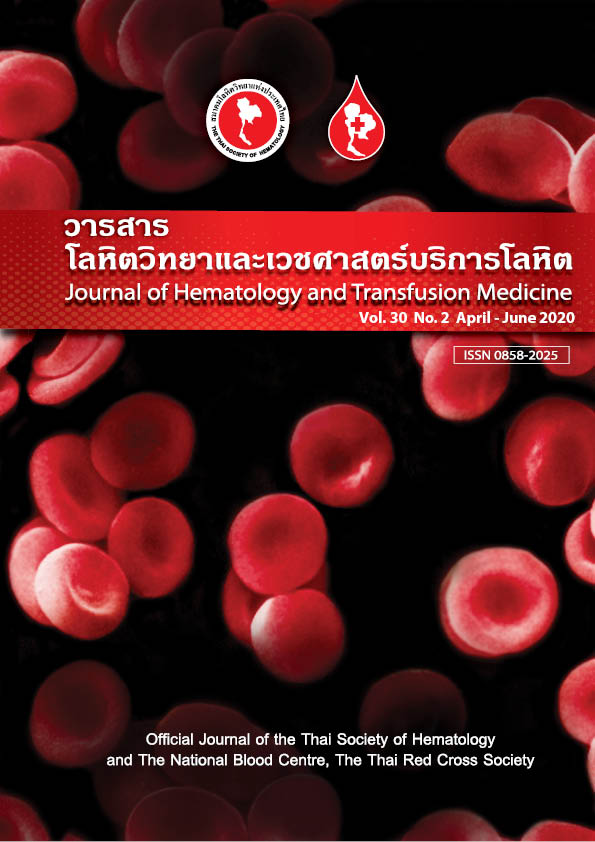Outcomes from adjusting the diagnostic criterion for beta-thalassemia carrier status using hemoglobin A2 level more than 3.5% from a betathalassemia prenatal control program in lower northern Thailand
คำสำคัญ:
เบต้าธาลัสซีเมีย, ฮีโมโกลบินแอลทู, คู่เสี่ยงบทคัดย่อ
บทนำ การตรวจคัดกรองพาหะของ beta-thalassemia เพื่อใช้กำหนดคู่เสี่ยง beta-thalassemia ในประเทศไทยใช้การตรวจวิเคราะห์ hemoglobin (Hb) typing เป็นหลัก โดยพิจารณาจากสัดส่วนของ Hb A2 ปัจจุบันกรมวิทยาศาสตร์การแพทย์ กระทรวงสาธารณสุข ได้ปรับเกณฑ์สัดส่วนของ Hb A2 เพื่อวินิจฉัยพาหะของ beta-thalassemia จากมากกว่าหรือเท่ากับร้อยละ 4.0 เป็นมากกว่าร้อยละ 3.5 เท่ากันทั่วประเทศ
วัตถุประสงค์ เพื่อตรวจหา beta-globin mutation ในตัวอย่างเลือดที่มีสัดส่วนของ Hb A2 อยู่ในช่วงร้อยละ 3.6-3.9 และศึกษาผลกระทบจากการเปลี่ยนเกณฑ์ดังกล่าวต่อระบบการตรวจวินิจฉัยเพื่อควบคุมโรค
วิธีการ รวบรวมตัวอย่างเลือดของคู่สามีภรรยาที่ส่งตรวจเพื่อกำหนดคู่เสี่ยงธาลัสซีเมีย ณ หน่วยวิจัยธาลัสซีเมีย ศูนย์วิจัยโลหิตวิทยา โรงพยาบาลมหาวิทยาลัยนเรศวร ช่วงเดือนตุลาคม 2557 ถึง ธันวาคม 2561 โดยคัดเลือกเฉพาะตัวอย่างที่มีสัดส่วนของ Hb A2 อยู่ในช่วงร้อยละ 3.6-3.9 นำมาตรวจ หา beta-globin mutation ด้วยวิธี real time-PCR ร่วมกับ high resolution melting analysis และ DNA sequencing นำผลการตรวจที่ได้มาพิจารณาร่วมกับผลการตรวจของคู่สมรสเพื่อยืนยันคู่เสี่ยง เปรียบเทียบภาระงานและจำนวนคู่เสี่ยงที่เพิ่มขึ้น
ผลการศึกษา จากคู่สามีภรรยาที่ส่งตรวจเพื่อกำหนดคู่เสี่ยงของ beta-thalassemia ทั้งสิ้น 7,110 คู่ พบผูที้่เป็นพาหะของ beta-thalassemia ที่มีสัดส่วนของ Hb A2 อยู่ในช่วงร้อยละ 3.6-3.9 จำนวน 41 ราย ตรวจพบ beta-globin mutation 7 ราย (ร้อยละ 17.1) เป็น beta0-thalassemia mutation 2 ราย [IVS-1 nucleotide (nt) 1 (G>T), codon 41/42 (-TTCT)] และ beta+-thalassemia mutation 5 ราย [nt -31 (A>G), nt -28 (A>G), codon 126 (GTG>GGG)] การปรับเกณฑ์การวินิจฉัยดังกล่าวทำให้มีคู่เสี่ยงของ beta-thalassemia เพิ่มขึ้น 26 คู่ จากเดิม 262 คู่ คิดเป็นภาระงานที่เพิ่มขึ้นร้อยละ 9.9 ยืนยันการวินิจฉัยคู่เสี่ยงจากการพบ beta-globin mutation จำนวน 4 คู่ คิดเป็นคู่เสี่ยงจริงที่เพิ่มขึ้นร้อยละ 1.5
สรุป ภาระงานที่เกิดจากผลบวกลวงที่เพิ่มขึ้นจากการปรับเกณฑ์วินิจฉัยดังกล่าวดูไม่มากนักเมื่อเทียบกับจำนวนคู่เสี่ยง beta-thalassemia ที่ตรวจพบทั้งหมด โดยพบคู่เสี่ยงจริงเพิ่มขึ้น จึงนับเป็นการลงทุนที่คุ้มค่า อย่างไรก็ดีผลบวกลวงดังกล่าวอาจนำไปสู่การตรวจวินิจฉัยก่อนคลอดโดยไม่จำเป็นเพิ่มขึ้นเช่นกัน
Downloads
เอกสารอ้างอิง
2. Rosnah B, Nani Shahida S, Mohd Nazri H, Marini R, Noor Haslina MN, Shafini MY, et al. The Diagnosis of Beta Thalassemia with Borderline Hb A2 Level among Kelantan Population. J Blood Disord Transfus 2017; 8:5
3. Steinberg MH, Adams JG 3rd. HaemoglobinA2: origin, evolution and aftermath. Blood 1991; 78:2165-77.
4. Practice Guideline in Laboratory for Prevention and Control of Thalassemia. Nonthaburi: Department of Medical Sciences, Ministry of Public Health, 2016.
5. Duangrueng S, Sangkitporn S, Panachamnong N, Kakunmalee C, Nuttabut P, Sangkitporn S. The study of beta-thalassemia mutation in samples with Hb A2 fraction of 3.5-4.0%. Abstract of the 22nd National Thalassemia Conference; 2017 Jul 6-7; Bangkok, Thiland. p. 47.
6. Chaweephisal P, Phusua A, Fanhchaksai K, Sirichotiyakul S, Charoenkwan P. Prevalence and genotypes of beta-thalassemia carriers in northern Thai population with borderline hemoglobin A2 levels. Abstract of the 23rd National Thalassemia Conference; 2018 Sep 4-6; Bangkok, Thailand. p. 38.
7. Sirichotiyakul S, Saetung R, Sanguansermsri T. Analysis of beta–thalassemia mutations in northern Thailand using an automated fluorescence DNA sequencing technique. Hemoglobin 2003; 27:89-95
8. Giambona A, Passarello C, Vinciguerra M, Muli RL, Teresi P, Anza M, et al. Significance of borderline hemoglobin A2 values in an Italian population with a high prevalence of beta-thalassemia. Haematologica 2008; 93:1380-4.
9. Lou JW, Li DZ, Zhang Y, He Y, Sun MN, Ye WL, et al. Delineation of the molecular basis of borderline hemoglobin A2 in Chinese individuals. Blood Cells Mol Dis. 2014;53:261-4.
10. Perseu L, Satta S, Moi P, Demartis FR, Manunza L, Sollaino MC, et al. KLF1 gene mutations cause borderline HbA2. Blood 2011;118:4454-8.



